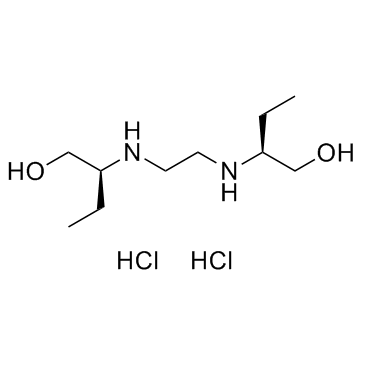1070-11-7
| Name | ethambutol dihydrochloride |
|---|---|
| Synonyms |
2,2'-(Ethane-1,2-diylbis(azanediyl))bis(butan-1-ol) dihydrochloride
(S,S)-N,N'-Bis(1-hydroxy-2-butyl)ethylenediamine Dihydrochloride (2S,2'S)-2,2'-(Ethane-1,2-diylbis(azanediyl))bis(butan-1-ol) dihydrochloride (S,S)-2,2'-(1,2-Ethanediyldiimino)bis-1-butanol Dihydrochloride (2S,2'S)-2,2'-(Ethane-1,2-diyldiimino)dibutan-1-ol dihydrochloride Ethambutol hydrochloride Ethambutol dihydrochloride (2S,2'S)-2,2'-(1,2-Ethanediyldiimino)di(1-butanol) dihydrochloride 1-Butanol, 2,2'-(1,2-ethanediyldiimino)bis-, (2S,2'S)-, hydrochloride (1:2) MFCD00216025 EINECS 213-970-7 2,2'-[1,2-Ethanediyldi(imino)]di(1-butanol) dihydrochloride |
| Description | Ethambutol Dihydrochloride is a bacteriostatic antimycobacterial agent, which obstructs the formation of cell wall by inhibiting arabinosyl transferases.Target: AntibacterialEthambutol directly affects two polymers, arabinogalactan (AG) and lipoarabinomannan (LAM) in Mycobacterium smegmatis. In M. smegmatis, Ethambutol inhibits synthesis of arabinan completely and inhibits AG synthesis most likely as a consequence of this; more than 50% of the cell arabinan is released from the bacteria following Ethambutol treatment, whereas no galactan is released. Ethambutol main targets against embB gene product in M. avium. Ethambutol induces 60% changes in the embB gene in M. tuberculosis resistant mutants [1]. Ethambutol is effective against actively growing microorganisms of the genus Mycobacterium, including M. tuberculosis. Nearly all strains of M. tuberculosis and M. kansasii as well as a number of strains of the M. aviumcomplex (MAC) are sensitive to Ethambutol. [1] Ethambutol is potency against M. tuberculosis (H37Rv) with MIC of 0.5 μg/mL in vitro [2]. Ethambutol is efficient on treatment of mycobacterial-infected macrophages. When M. tuberculosis infected macrophages are treated with 6 μg/mL Ethambutol, the log CFUs following treatment for 3 days is 4.17, while value in control group is 4.8. The MICs for M. avium (MTCC 1723) and M. smegmatis (MTCC 6) are 15 μg/mL and 0.18 μg/mL, respectively. Ethambutol is efficient in animal model. 100 mg/kg Ethambutol given orally 15 days post i.v. infection 1 ×/week for 5 weeks, induces a lower log CFU compared with untreatment (4.59 vs 5.07) [3]. |
|---|---|
| Related Catalog | |
| References |
[1]. Ethambutol. Tuberculosis (Edinb), 2008. 88(2): p. 102-5. |
| Boiling Point | 345.3ºC at 760 mmHg |
|---|---|
| Melting Point | 198-200°C |
| Molecular Formula | C10H26Cl2N2O2 |
| Molecular Weight | 277.232 |
| Flash Point | 113.7ºC |
| Exact Mass | 276.137146 |
| PSA | 64.52000 |
| LogP | 2.09320 |
| Vapour Pressure | 3.35E-07mmHg at 25°C |
| Storage condition | Refrigerator |
CHEMICAL IDENTIFICATION
HEALTH HAZARD DATAACUTE TOXICITY DATA
MUTATION DATA
|
| Symbol |

GHS08 |
|---|---|
| Signal Word | Danger |
| Hazard Statements | H360 |
| Precautionary Statements | P201-P308 + P313 |
| Personal Protective Equipment | Eyeshields;full-face particle respirator type N100 (US);Gloves;respirator cartridge type N100 (US);type P1 (EN143) respirator filter;type P3 (EN 143) respirator cartridges |
| Hazard Codes | T: Toxic; |
| Risk Phrases | R61 |
| Safety Phrases | S53-S22-S36/37/39-S45 |
| RIDADR | NONH for all modes of transport |
| WGK Germany | 3 |
| RTECS | EL3854000 |
| HS Code | 2922191000 |
| HS Code | 2922191000 |
|---|

